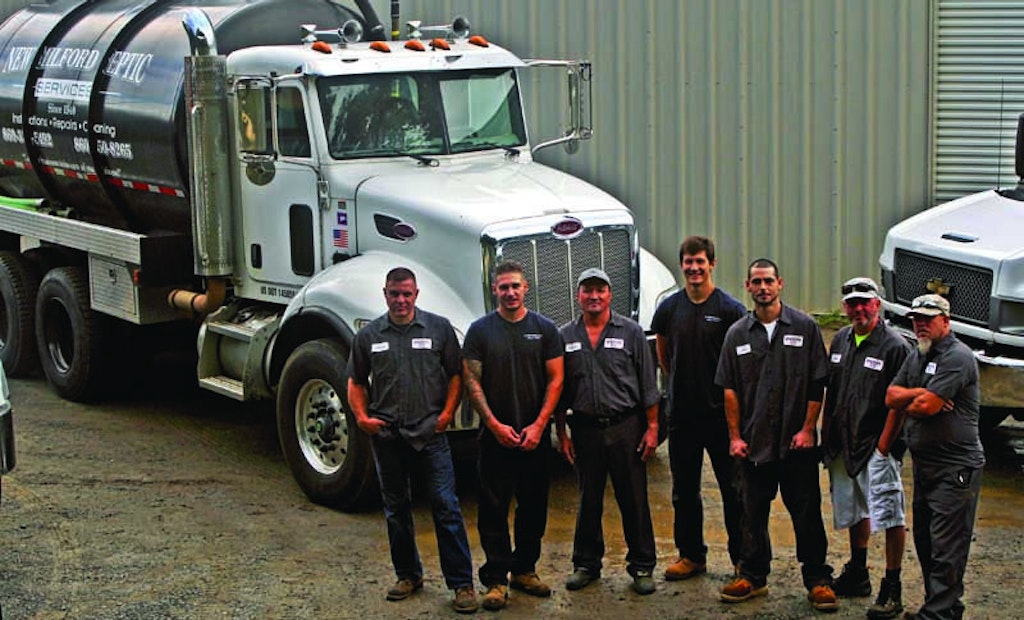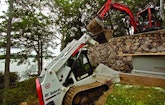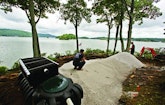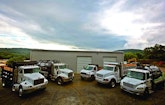
Interested in Systems/ATUs?
Get Systems/ATUs articles, news and videos right in your inbox! Sign up now.
Systems/ATUs + Get AlertsStriving to achieve simplicity governs George Sam’s life. As a police officer in New Milford, Connecticut, Sam’s ability to reduce complicated situations to their lowest common denominators often defused volatile situations. Later, after he left law enforcement for the onsite industry, it helped him eliminate unnecessary complexities and overcome his greatest professional challenges.
In the mid-1990s, as his father-in-law slowly retired from his company, New Milford Septic Services, Sam and his wife, Heather, progressively assumed more responsibilities. They took over in 2000.
“The business model hadn’t changed since my wife’s grandfather opened the doors in 1940,” says Sam. “We still had 12 employees comprising five septic pumping crews and two full-time installation crews from when work peaked in the 1980s.”
To compensate for intense competition shrinking their customer base, Sam streamlined the company until he found its perfect operating size. It took five years. When the economy collapsed in 2008, New Milford Septic rolled on, unaffected and prosperous.
UPDATING THE BUSINESS
Sam’s four-phase reconstruction plan involved modernizing the fleet, evaluating how they did business, building a new shop, and updating recordkeeping methods.
“When I climb on a machine, it should run,” says Sam, 46. “Keeping equipment until the last bolt falls out is counterproductive.” He sold all the old heavy equipment except the Caterpillar 311 CU excavator, then purchased a Caterpillar 307 CU mini-excavator, Kubota KX161 and U-25 compact excavators, a Bobcat T-630 compact track loader, and a Komatsu WA-200 wheel loader.
Appraising how the business functioned changed its course 180 degrees. “At our height, we installed or repaired 250 stone trench systems with 4-inch perforated pipes per year, and bid on large installation projects that took two to three weeks to complete,” says Sam. “By 2000, 25 contractors in our 25-square-mile service radius had made being a professional estimator impractical.”
Instead, brother Chris, age 48, and Roberto Alvarez concentrated on little repair jobs previously rejected by the company. They replaced baffles, risers, tank lids, sewage pumps, piping and distribution boxes. “By close of our first year, revenue had increased dramatically,” says Sam.
Today, their profit margin holds at 30 to 40 percent, with 75 percent of the work residential and 25 percent commercial. Pumping 2 to 3 million gallons per year generates 60 percent of revenue, and installing or repairing onsite systems produces the rest. Septage is off-loaded at four local municipal wastewater treatment plants.
INVENTORY CONTROL
To make repair items readily available, the brothers bought 2 1/2 acres in 2006 and built a 3,500-square-foot shop with office, two service bays and a storage yard. They purchased sewage pumps from Liberty Pumps, Tuf-Tite baffles, and Polylok Inc./ Zabel effluent filters from HD Supply.
“I also saw the housing market heating up and knew earth products would soon sell at premium prices,” says Sam. “A storage yard allowed me to buy cover fill, topsoil and septic sand in bulk. Now we load the trucks with what we need and go.”
Digitizing recordkeeping became everyone’s task, not just the responsibility of part-time office manager Lorie McMullin and marketing director/office assistant Heather Detrick. “We tested various bookkeeping applications, but they were too complicated,” says Sam. “We settled on QuickBooks (Intuit), QuickBooks Customer Manager and Google Calendar. They are simple to use and easily tailored to our needs.”
Recordkeeping is based on property addresses, and Sam wants a digital profile for each one. To that end, customer tickets have a place for drawing a map of every point technicians may need to reference in the future. Then the ticket is scanned and saved.
Part of modernizing the company involved streamlining the payroll. It evolved to two pumping crews, one installation crew, and one service and inspection crew.
Tyler Fairchild and Benny Smith comprise the main septic service crew. They drive a 2008 Peterbilt 340 vacuum truck with 3,250-gallon Presvac Systems steel tank and Challenger 367 (National Vacuum Equipment). Tom Nelson operates the 2006 Freightliner M2-106 vacuum truck with 2,600-gallon Imperial Industries steel tank and Jurop/Chandler PN84 pump. Nelson collects overflows from the main truck, handles emergency pumpouts, cleans decommissioned septic tanks, and often works on the installation crew manned by the brothers and Alvarez. Chris Sam and Alvarez also double as the service and inspection crew.
COMPREHENSIVE INSPECTION
The company has mapped out a 20-point system inspection during pumpouts. It also locates old concrete septic tanks with structural deficiencies. “We replace 25 such tanks per year and install 50 systems,” says George Sam. “Because the state Department of Public Health doesn’t allow advanced treatment units, we’re restricted to stone and pipe trenches, leaching chambers and proprietary leaching products.”
System inspections always include a visual examination of the tank baffles, sidewalls and lid. If applicable, technicians lower an iPhone on a selfie stick and video the interior. They survey the yard for blowouts, soft or wet spots, green grass, and anomalies such as trees planted near systems or structures built over tanks. They also record if driveways are sloped or flat, if they are accessible by truck in the winter, and how many lengths of hose are needed to reach the tank. Inspection forms are digitized and become part of the customer’s record.
The region’s low mountains and small lots often necessitate installing replacement drainfields in the original’s footprint. When the state approved preassembled leaching products such as the Mantis system (Eljen Corp.) and S-Box (Geomatrix Systems), the brothers saw another opportunity to advance their professionalism. They turned to Spencer Myles, a soil scientist at Arthur H. Howland & Associates, for help.
“Myles taught us about soil methodology, microbiology, long-term acceptance rates, and how to marry replacement systems to the soil,” says Sam. “Soil identification remains the biggest reason our systems work better. We know where to put the drainfields. We also excavate contaminated absorption beds, then build up the proper vertical separation with septic sand.”
TOUGH CHALLENGE
Sam educates people — especially those looking at only price points — about the varying levels of quality in a service industry. “Education ensures the best outcome for both sides,” he says. “We build customer confidence through the care we give them and their systems. In return, repeat customers drive our business.”
Earning trust is seldom easy and often involves unique projects such as replacing a failed system on Candlewood Lake. A power company owns the hydro reservoir and all the shoreline up to the 440-foot elevation line. As the topographical line follows the lake, it undulates through roads and people’s property.
“The customer owned lots 8 and 10, separated by 300 feet of projecting shoreland,” says Sam. “His house, built on a ledge, had no replacement area. Lot 10 did.”
Sam obtained an easement to run a force main across the shoreland. The 900 gpd system he designed included:
- 1,000-gallon polyethylene septic tank with 500-gallon pump chamber (Roth Global Plastics)
- Two alternating 1/2 hp Liberty sewage pumps
- 18 Recharger 280 chambers (CULTEC Inc.)
- Duplex control panel (SJE-Rhombus)
The original septic tank alongside the house was 12 inches from the property line. “This job was variance heaven,” says Sam. “Forget about setbacks.”
The 5-foot-deep trench across the shoreland was below the frost line and water table. As the crew dug, the trench filled immediately with water, restricting progress to feet at a time.
WORKING CAREFULLY
Chris Sam and Alvarez glued two 40-foot sticks of 4-inch SDR 35 sewer pipe together as George Sam excavated with the KX161. They tied a rope to a bolt in the lead pipe and the other end to the excavator bucket, pulled in the sleeve, and backfilled immediately to prevent a cave-in. They repeated the process until reaching their destination. The vacuum truck sucked the water from the sleeve.
“We couldn’t risk anything breaking on the power company’s property,” says George Sam. “That’s why we sleeved the 2-inch force main tubing. The 300-foot-long coil fought us every inch of the way.”
Then the crew constructed a 10-foot-wide gravel road 100 feet up a 15 percent grade to the drainfield. They cut 5 feet from the high side of the hill and filled 3 feet on the low side to create a flat road. The 1999 Sterling LT 9500 tri-axle dump truck with 18-cubic-yard Beau-Roc box stockpiled materials, and the 2006 Chevy 5500 six-wheel dump truck with 5-cubic-yard Beau-Roc box moved them up the hill as needed. The company also runs a 2001 Peterbilt dump truck with a Beau-Roc body.
Sam scooped out the 80- by 109-foot-wide drainfield at the end of the road, then used the bucket to position materials. “We bedded with 2 inches of crushed stone, then lay two 75-foot-long rows of chambers on 5-foot centers,” he says. “It took 50 cubic yards of septic sand and 100 cubic yards of clean cover fill to blend the drainfield into the hill.” Before leaving, they restored all properties to their original condition.
WHERE CREDIT IS DUE
Sam gives the credit to New Milford Septic employees for successful completion of tough jobs. He says he gives them autonomy to handle the work at hand, and hopes some day they will purchase the company from him.
“I credit them for where we are today,” he says. “The work is hard and unglamorous, yet they pull together with a will to overcome all obstacles. They never stop trying to do their best.”
‘I didn’t think I’d come home’
Replacing a corroded 500-gallon metal septic tank at the bottom of a 70-degree slope abutting Candlewood Lake was the ultimate challenge for George Sam of New Milford Septic Services. “No one wanted the job because it was dangerous,” he says. “However, the homeowner pleaded and I finally agreed.”
The 8-foot-wide access road was almost too narrow for the Peterbilt vacuum truck. The road also dipped and turned, making it impossible for drivers to see what was coming over the crests. To avoid an accident, a worker walked ahead of the truck as a guide.
Tyler Fairchild grasped trees and vegetation to maintain his balance as he and the hoses careened down the slope. Ascending was a hand-over-hand battle against gravity.
Sam hired a tow truck to lower his new Kubota U-25 excavator to the shore. “We hitched the boom winch cable to the machine, then I rode it down with my heart in my throat.” After removing the existing tank, the crew installed a 1,000-gallon polyethylene septic tank (Roth Industries), plumbed it, and backfilled.
Walking the excavator up the grade with the tank remains chained behind was the most terrifying. “At the crest, the terrain switched from soft earth to hard asphalt,” says Sam. “If the sharp change snapped the cable, everything would go back down with no way to recover. That was the day I didn’t think I’d come home.”









